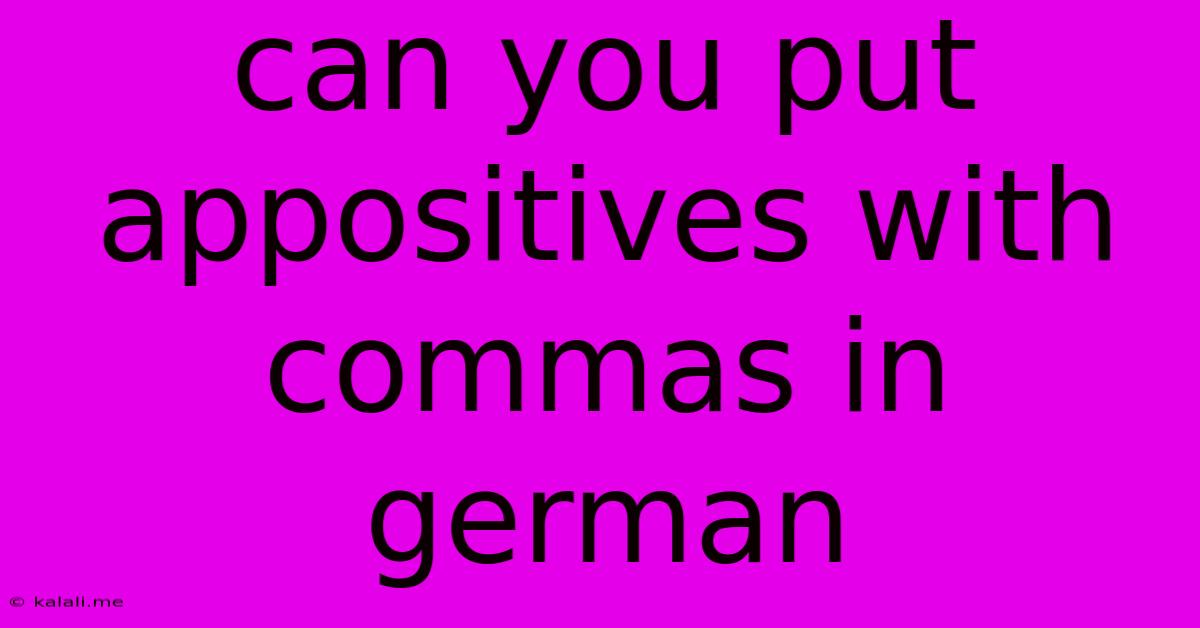Can You Put Appositives With Commas In German
Kalali
May 24, 2025 · 3 min read

Table of Contents
Can You Put Appositives with Commas in German? A Comprehensive Guide
Appositives – those descriptive phrases that rename or explain a noun – are a common feature in English writing, often set off by commas. But how do they work in German? This article delves into the nuanced rules surrounding appositives and comma usage in German, helping you confidently punctuate your sentences. Understanding appositives is crucial for mastering German grammar and writing clear, concise, and grammatically correct sentences.
The short answer is: yes, you can use commas with appositives in German, but the rules aren't always as straightforward as in English. The key lies in understanding the relationship between the appositive and the noun it modifies.
Understanding Appositives in German (Appositionen)
An appositive in German, or Apposition, is a phrase that adds extra information about a noun or pronoun. It's essentially a second way of naming the same thing. Unlike English, where commas are frequently used, the comma usage in German appositives depends on several factors, including the closeness of the relationship between the appositive and the main noun.
Consider these examples:
-
Mein Bruder, der Arzt, ist sehr beschäftigt. (My brother, the doctor, is very busy.) Here, the appositive "der Arzt" (the doctor) is set off by commas because it's a non-restrictive appositive – it adds extra information but isn't essential to identifying the brother.
-
Mein Bruder Arzt ist sehr beschäftigt. (My brother, a doctor, is very busy.) This sentence omits the commas. This is a restrictive appositive—the information is crucial to understanding which brother is being discussed. If the commas were added, it would imply there's only one brother, and he's a doctor.
When to Use Commas with Appositives in German
Commas are typically used with appositives in German when:
-
The appositive is non-restrictive: This means the information provided by the appositive is additional, not essential to understanding the sentence's core meaning. These appositives are often longer and provide further details. They are set off with commas, much like in English.
-
The appositive is a full clause: If the appositive is a complete clause (containing a subject and verb), it will almost always be set off by commas.
When Commas are NOT Used with Appositives in German
Commas are generally omitted when:
-
The appositive is short and restrictive: Short, defining appositives that are essential for identifying the noun are typically not separated by commas. They integrate more closely with the main noun.
-
The appositive is a single adjective or noun phrase: A simple adjective like ein guter Freund (a good friend) or a short noun phrase directly modifying the preceding noun wouldn't require commas.
Examples Illustrating Comma Usage
Let's examine more examples to solidify your understanding:
-
Berlin, die Hauptstadt Deutschlands, ist eine wunderschöne Stadt. (Berlin, the capital of Germany, is a beautiful city.) – Commas used due to non-restrictive appositive.
-
Mein Freund Peter ist gekommen. (My friend Peter has come.) – No commas, as "Peter" is restrictive.
-
Das Buch, das ich gestern gelesen habe, war sehr spannend. (The book that I read yesterday was very exciting.) – Commas used because the appositive is a full clause.
-
Der Film Actionheld war fantastisch. (The film action hero was fantastic.) -No commas; it's a short, restrictive appositive.
Mastering Appositive Punctuation: Practice Makes Perfect
The best way to master comma usage with appositives in German is through practice. Pay close attention to the context and the relationship between the appositive and the noun it modifies. Reading extensively in German and analyzing the punctuation used in various texts will significantly enhance your understanding and improve your writing skills. By carefully considering the restrictive or non-restrictive nature of the appositive, you can confidently use commas correctly in your German writing.
Latest Posts
Latest Posts
-
How To Fix A Leaky Outdoor Faucet
May 24, 2025
-
What Day Did God Create Man
May 24, 2025
-
How Do You Get Rid Of Drain Flies
May 24, 2025
-
How To Clean Jacuzzi Jets In Bathtub
May 24, 2025
-
How To Get Gas Smell Out Of Hands
May 24, 2025
Related Post
Thank you for visiting our website which covers about Can You Put Appositives With Commas In German . We hope the information provided has been useful to you. Feel free to contact us if you have any questions or need further assistance. See you next time and don't miss to bookmark.